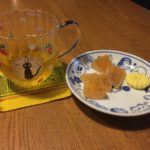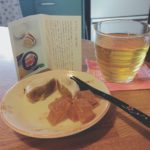冬瓜漬: tougatsuke, tougadzuke. The first 2 kanji are 冬瓜 tougan, which is “winter melon” in English. The last kanji is 漬 (usually ‘tsuke’) meaning “pickle” or “preserve.” So the meaning of this term is something like pickled/preserved winter melon.
Tougan is also known as shibui しぶい in Okinawan language. It is a very hearty and cheap vegetable here in Okinawa. The word winter melon is sort of funny, because it is actually harvested in summer, but it is easy to store these and they will last all winter, so hence winter melon.
Anyway, I recently visited the Jahana Kippan Shop 謝花きっぱん店 in Naha. These shop is the only shop that still makes 2 very famous Ryukuan sweets called kippan and tougatsuke. During the Ryukyu kingdom era, these sweets were enjoyed by the emperor and high ranking nobles as delicacies, one of the 16 types of special fruits and desserts served in the Royal Court. This shop has amazing quality sweets, everything I sampled was so good; since I am a student, my budget was the “imperfect” pieces that they sold in small bags instead of the beautiful perfectly shaped ones.
To make tougatsuke, the juiciest flesh from tougan is used, as well as Okinawan sugarcane. There are no preservatives or artificial flavors here, just natural food made in the same style as the Ryukyu kingdom era. It is amazing that a simple tougan is turned into this sweet concoction! They recommend keeping it chilled, slicing thin pieces, and serving with tea or dessert wine. It is hard to describe the exact flavor– it was very sweet, and a little juicy, sort of melts in your mouth. An excellent pairing with some green tea.
Update: I later purchased the shiqwasa flavored tougatsuke and it is also delicious. I sampled the Okinawan sugarcane rum flavor in the store as well, and it was nice with a hint of rummy flavor.
Address:Okinawa, Naha, Matsuo 1-5-14
https://goo.gl/maps/vhUKgGsApJu





